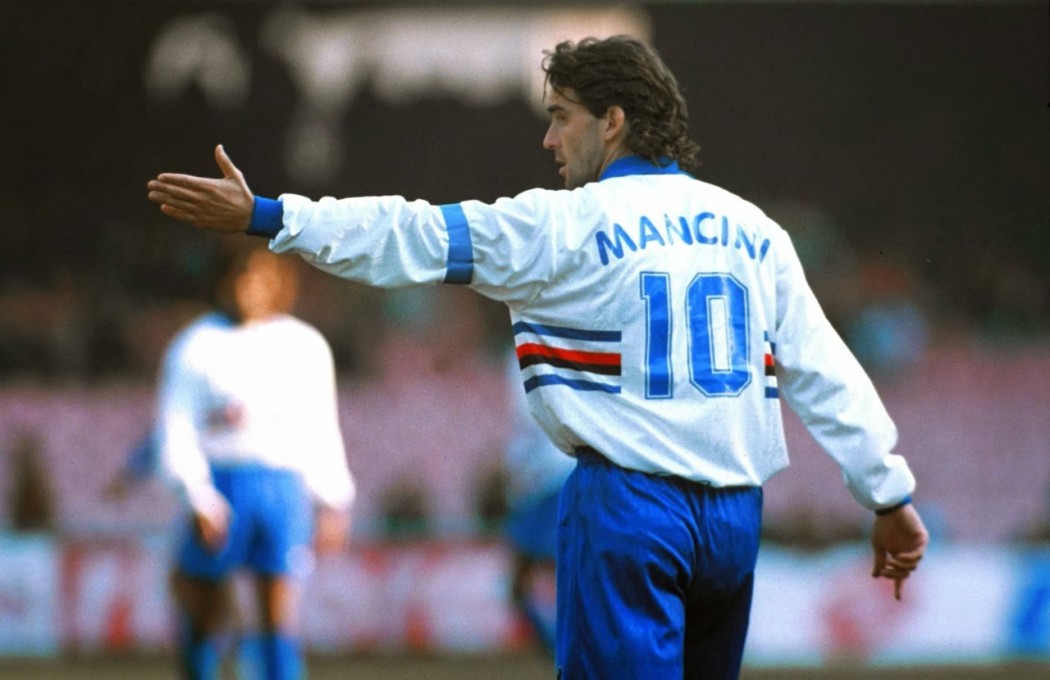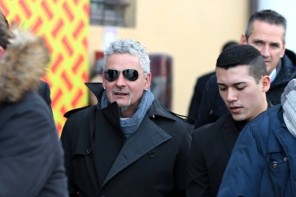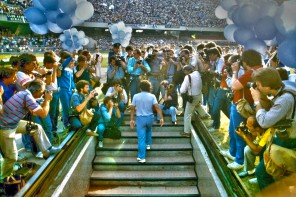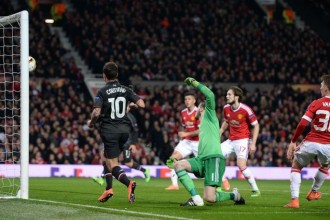As a player, Roberto Mancini is best remembered as a fiery and temperamental, yet brilliant forward for Sampdoria, and later Lazio. One half of the famous ‘goal twins’ strikeforce, the former Samp No.10 struck up a fearsome partnership with Gianluca Vialli which won Serie A and almost clinched a European Cup.
Whilst watching Mancini during his peak years, although placed as part of a front two in a starting line-up, it was quite evident during games that he was a ‘Number 10’, with all the attributes and essence of a fantasista, that he would quite often naturally drift into a trequartista role.
Fast-forward to the end of his playing days and Mancini was set on becoming a coach, and to do so, had to write a coaching thesis on a topic of his choice to submit to the Italian Football Federation – a normal practice when Italian managers take their coaching badges.
Mancini presented his ‘Master’s Course’ thesis during the 2000/2001 season at Coverciano. His chosen topic? “The Trequartista.”
His fascinating insight into the role lifts the lid on his personal experiences as a player, who encountered various difficulties in being trusted to play as a trequartista by his coaches – therefore feeling he was unable to maximise his potential.
He also provides expert analysis, coupled with his natural ability and comprehension of the role, its characteristics, the formations which best suit it, and why there is a need for such a player in a team.
Now a coach himself who’s worked in some of the highest profile jobs in Europe, the difficulties Mancini mentions as a former player are perhaps made even more enlightening considering the approaches he has taken when the pressure of management is on.
What follows are segments taken directly from Mancini’s thesis:
The magic of the number 10 comes from the trequartista‘s feet, the player of inventiveness, the one who is capable of wrong-footing everyone with a piece of skill perhaps he is not even fully aware of.
Personal experience
My career began in an amateur youth team where it came natural to to place myself between the midfield and strikers. At the age of 13, I went to play for Bologna and played for every youth team sector as a trequartista – a wonderful role because it allowed me to always be in the heart of the game, start plays, set-up others or find the net myself.
The best thing was always be very important for the team – in a few words: the player who made a difference.
At the age of 16, I made my Serie A debut. Unfortunately, Bologna wasn’t a great side and so the coach, Tarcisio Burgnich, decided to play me – to our collective great regret – as a pure striker, due to our position in the table, the team’s tactical balance, and the fact that I could score goals.
I scored nine times, but Bologna were relegated and Sampdoria (in Serie A) signed me. My wish for the new season was to finally be able to play in my role: the trequartista. The season began and my dream was shattered by the new coach in an instant when I told him my aspirations and he got up and walked away. My dream ended before even starting.
Now that I’m no longer a football player, I’m very fond of my career as a forward, but I think it would have been better if I could have played in my natural role as a trequartista. I say this because unfortunately, a player with these characteristics has to be lucky to find both a certain type of team, and above all, a coach who also knows how to adapt his own plans.
Who is the Trequartista in a team’s line-up?
From the perspective of “football culture”:
The trequartista is a player equipped with great technical skills and specific characteristics:
– Sublime capacity for losing his marker.
– Great basic technical skills and good technically-applied quality.
– Unpredictability.
– Ability to conjure assists for strikers with ease in various ways.
– A predisposition for dribbling and individual play.
– A scarce presence in the defensive phase of the pitch.
From the perspective of the “position on the pitch”.
The trequartista is a player who places himself in the central zone between the midfielders and the strikers’ lines.
Historical Notes
Zico, Michel Platini and Diego Maradona are the best expressions that football has produced in the role over the last 20 to 25 years.
In the 90s, the role fell into a crisis: coaches frequently sacrificed the historical ‘Number 10’ figure, reasoning the need to add balance to their team. It is difficult to understand if such choices – which led to a few years of speculative and muscular football – were dictated by theoretical reasons or by the lack of “talented players.”
In recent years there has been a resurgence: today many teams are ‘built’ around the trequartista (e.g. Brescia and Juventus).
However the role has undergone a strong evolutionary process: Zidane, Rivaldo, Rui Costa and others are very different players to their counterparts from the past; they combine undisputed technical qualities with good physical skills that allow them to participate more actively in the ball recovery phase.
The different physical make-up of the “new trequartistas” permits them to compensate for the reduction of space and time to “play the ball.” Hence the fantasisti have also had to adapt to a more athletic football where the “technique” is no longer enough to emerge at certain levels, if not supported by good physical and character traits. For all these reasons, it is increasingly difficult for the trequartista to “make a difference”, as used to happen in the past. At least this explains the choice to give up on the trequartista, especially by mid-low table teams. However, they can still give something extra with their personal characteristics. For all these reasons, today it is easier for teams to support – rather than bear – the modern “Number 10.”
Observations of the Trequartista
A statistical definition of the role:
Trying to define, in an objective manner, if a player belongs to the role of a trequartista or not, it’s possible to use a statistical survey that links each player to one of the eight roles – goalkeeper, fullback, centre-back, central midfielder, wide midfielder, central attacking midfielder or trequartista, supporting striker, pure striker – designed to identify their position and therefore give a meaningful assessment.
This research notes the position on the pitch the player is in when he comes into possession of the ball during a game, along with the time of possession for each ball played. It is then possible to attribute each player his true role. At the end of the season, we can calculate an average density using all of the data obtained during the season.
In such a way, you are able to attribute a role to any player. In accordance with this model, there are only 11 players in the current Serie A league who fit into the trequartista category. [Note: From that season, they included Roberto Baggio and Andrea Pirlo (Brescia), Rui Costa (Fiorentina), and Zinedine Zidane (Juventus).]
Which system does the trequartista fit into?
The presence of a trequartista doesn’t necessarily impose a certain formation, because teams change their tactics during a game (and/or season) and because the role of a trequartista can have very different aspects. However, most of the teams playing with a “central attacking midfielder” are lined up in a 3-4-1-2 (e.g., Bologna, Parma, Inter or Vicenza). Other teams – such as Juventus and Fiorentina – use the 4-3-1-2 which requires fullbacks very good at pushing forward and three midfielders more dynamic and inclined to intercept.
Then there are teams fielded in a traditional 4-4-2 where there is a player with more freedom to move and support the offensive department.
 Otherwise, the trequartista can also play in systems set out with a lone striker (Fiorentina, Lazio and Brescia).
Otherwise, the trequartista can also play in systems set out with a lone striker (Fiorentina, Lazio and Brescia).
 As we have already said, there are potential trequartistas who find space in the offensive department to take advantage of their skills close to the opponents’ area but don’t burden the team with their poor attitude to interceptions. After all, Roma’s situation with Totti is also clear since he has played more as second striker than trequartista and with the hypothetical supporting striker (Delvecchio) often more backward on the left-wing.
As we have already said, there are potential trequartistas who find space in the offensive department to take advantage of their skills close to the opponents’ area but don’t burden the team with their poor attitude to interceptions. After all, Roma’s situation with Totti is also clear since he has played more as second striker than trequartista and with the hypothetical supporting striker (Delvecchio) often more backward on the left-wing.
 Beyond personal characteristics and inclusion in various systems, the trequartista is an artist who knows how and where to lose his marker depending on where ball, team-mates and opponents are.In other words, he has a 360-degree vision and when he comes into possession he can create something new.
Beyond personal characteristics and inclusion in various systems, the trequartista is an artist who knows how and where to lose his marker depending on where ball, team-mates and opponents are.In other words, he has a 360-degree vision and when he comes into possession he can create something new.
What does the trequartista do on the pitch?
As mentioned, within a group of trequartistas there are players with different characteristics.
Offensive Phase
Generally, I truly think that the trequartista should have individual technique of the highest level, closely and quickly connected with a certain tactical intelligence. They are players capable of “pieces of skill”, but above all they can destabilise various defensive set-ups thanks to unpredictable intuition.
As we have already seen and read, this type of player looks to place himself between the midfield and striker central zone, looking for space and openings to dictate low and medium-length through balls. His attempt (especially when he moves the ball around to his midfielders) is to stay in the central zone, freeing himself of his marker in tight spaces.
While it is hard for his teammates to play the ball through to him, it’s also true if the trequartista receives the ball in that area, he becomes dangerous for the opponents. The trequartista, although receiving the ball with his back to his rival’s goal, has already read the entire situation around him before touching the ball and can understand when to stop and quickly turn in a single movement.
The trequartista become protagonists of the assist since they can easily set up team-mates to score or shoot. The assist average and the percentage of the team’s overall assists are two useful indicators to assess the performance of a trequartista. The contribution of trequartistas to the assists of a team is about 25%:
Except Baggio (33.7% of Brescia’s overall assists) and Pirlo (32.2% in relation to minutes played) who were facilitated by the technical gap that distinguished them from their teammates, the most efficient (in relation to the teams they play for) have been Rui Costa (29.4%) and Zidane (26.5%).
Another way for the trequartista to move around is finding space on the wings. And he does it with ease, sure of his ability to control the ball. This is usually a way to keep possession of the ball – the trequartista is skilled in “keep-ball” and then finds solutions on the opposite side. For right-footed players it becomes natural to go left – almost vice versa for left-footed ones – and then return to the center and serve assists in the form of inswinging crosses, lobs, through balls or spread the play with a long ball. This attitude or ability of “Number 10s” to spread to the flanks – as soon as he can with his body already turned inwards – is interesting.
When the situation is blocked, for example, because man-marking is used on the trequartista, we can verify that the player drops back to receive the ball because he needs to make his presence felt as much as possible. He is a player sought by all his teammates, so even in a deeper position he is able to keep possession of the ball, then give way to plays or runs, as quarterbacks in American football do. That’s why sometimes a trequartista is fielded along with one or two fast strikers running into space.
It is interesting to note how trequartistas distribute passes between short-medium length through balls (and lobs) and long ones. Obvious differences emerge: there are players like Zidane who do not like to rely on long balls, preferring to juggle in tight spaces with passes or dribbles; others play long balls more often:
| Through balls+lobs | Long balls | |
| ZIDANE | 52% | 9% |
| MICOUD | 60% | 12% |
| RUI COSTA | 50% | 14% |
| BAGGIO R | 56% | 17% |
| PIRLO | 55% | 21% |
The trequartista is also a player capable of creating numerical superiority in the most easy/difficult way of football: dribbling. They are self-confident players who never lose their cool and skillfully cause problems for their direct opponent, or can come out of complicated situations.
However, it is also important for the trequartistas to move into space in order to dictate important and decisive passes. In this way, trequartistas can create perfect harmony with other technically skilled players and serve important balls on a platter. Their charisma and their self-esteem give great ability from set pieces (see Baggio and Zidane).
Defensive Phase notes
We know that the trequartista is a player who seeks the best position on the field and his work is more inclined to the offensive phase.
It is clear that the probability of recovering balls is lower for the most offensive trequartistas. Actually they are not asked for particular covering tasks, if not for the need to drop back after losing the ball: not only to slow the opponents’ attack – the mere presence in a certain zone of the field can be useful – but above all to act as a reference point for their teammates as soon as they come into possession of the ball.
Indeed, I believe that it is important for the trequartista in transition between attack and defense to take the best position he decides. His task is to occupy an uncertain space that allows him or his team-mates to steal the ball. His aim is not to mark, but to move with intuition in search of a possible counterattack. His thought is: “If I or my team-mates recover the ball and give it to me, I can do this…”
Conclusion
I understand, and it’s right, that a team has a balanced and organized game, but I think there is always a need for these great players who:
– Make the difference in many games.
– Take responsibility when things don’t go well on and off the pitch.
– Help their less technically-gifted team-mates.
– Help the coach when the team isn’t playing well.
– Entertain the fans at times with extraordinary pieces of skill – which may anger the coach.
Roberto Mancini
You can read Mancini’s full thesis here.








